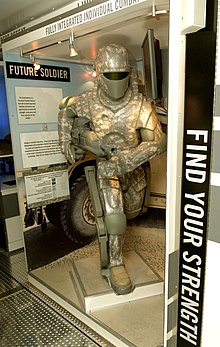
Back روبوت الهيكل الخارجي Arabic Ekzoskelet Azerbaijani Robotický exoskelet Czech Exoskelett (Maschine) German Eksterskeleto Esperanto Exoesqueleto mecánico Spanish Motoriseeritud eksoskelett Estonian پیرا اسکلت برقی Persian Eksoskeleton Finnish Exosquelette motorisé French

A powered exoskeleton (also known as power armor, powered armor, powered suit, cybernetic suit, robot armor, robot suit, high-tech armor, robotic armor, robot armor suit, cybernetic armor, exosuit, hardsuit, exoframe or augmented mobility[1]) is a mobile machine that is wearable over all or part of the human body, providing ergonomic structural support and powered by a system of electric motors, pneumatics, levers, hydraulics or a combination of cybernetic technologies, while allowing for sufficient limb movement with increased strength and endurance.[2] The exoskeleton is designed to provide better mechanical load tolerance, and its control system aims to sense and synchronize with the user's intended motion and relay the signal to motors which manage the gears. The exoskeleton also protects the user's shoulder, waist, back and thigh against overload, and stabilizes movements when lifting and holding heavy items.[3]
A powered exoskeleton differs from a passive exoskeleton, as the latter has no intrinsic actuator and relies completely on the user's own muscles for movements, adding more stress and making the user more prone to fatigue, although it does provide mechanical benefits and protection to the user.[4][5] This also explains the difference of an exoskeleton to orthotics, as orthosis mainly aims to promote progressively increased muscle work and, in the best case, regain and improve existing muscle functions. Currently, there are products that can help humans reduce their energy consumption by as much as 60 percent while carrying things.[6]
- ^ Ferguson, Alan (September 23, 2018). "Exoskeletons and injury prevention". Safety+Health Magazine. Retrieved October 19, 2018.
- ^ Blake McGowan (2019-10-01). "Industrial Exoskeletons: What You're Not Hearing". Occupational Health & Safety. Retrieved 2018-10-10.
- ^ Li, R.M.; Ng, P.L. (2018). "Wearable Robotics, Industrial Robots and Construction Worker's Safety and Health". Advances in Human Factors in Robots and Unmanned Systems. Advances in Intelligent Systems and Computing. Vol. 595. pp. 31–36. doi:10.1007/978-3-319-60384-1_4. ISBN 9783319603834.
- ^ Koopman, Axel S.; Kingma, Idsart; Faber, Gert S.; de Looze, Michiel P.; van Dieën, Jaap H. (23 January 2019). "Effects of a passive exoskeleton on the mechanical loading of the low back in static holding tasks" (PDF). Journal of Biomechanics. 83: 97–103. doi:10.1016/j.jbiomech.2018.11.033. ISSN 0021-9290. PMID 30514627. S2CID 54484633.
- ^ Bosch, Tim; van Eck, Jennifer; Knitel, Karlijn; de Looze, Michiel (1 May 2016). "The effects of a passive exoskeleton on muscle activity, discomfort and endurance time in forward bending work". Applied Ergonomics. 54: 212–217. doi:10.1016/j.apergo.2015.12.003. ISSN 0003-6870. PMID 26851481.
- ^ Bogue, Robert (2022-06-30). "Exoskeletons: a review of recent progress". Industrial Robot. 49 (5): 813–818. doi:10.1108/IR-04-2022-0105. ISSN 0143-991X. S2CID 248640941.
© MMXXIII Rich X Search. We shall prevail. All rights reserved. Rich X Search